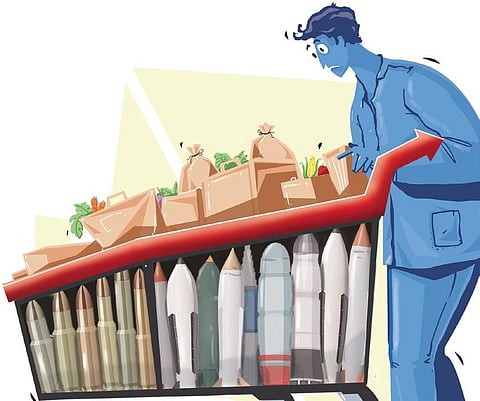

The Ukraine war is a lesson on how an unexpected geopolitical upheaval can lay to waste months and years of reconstruction. India, as other economies, were on the mend riding the post-Covid release of consumer demand and government infusion; only to see the brakes slammed again in the face of global disruption and the rise of hyper-inflation.
Research by the community social media research platform LocalCircles revealed 24% of Indian households have cut down on edible oil consumption.The survey further said 67% are paying higher cooking oil prices these last few months, and were forced to shift to cheaper low-quality oils opening families to serious health risks.
Shortages and disruption of transportation induced by the Ukraine war has forced up cooking oil prices worldwide 25-40% in the last 45 days. Edible oils such as sunflower, peanut oil, coconut and mustard oil, popular in India, are currently selling 50-70% over their pre-Covid levels.
ALSO READ | Where inflation stands today: Has it hit peak?
The storm signals are there for all to see. In a surprise move last week, the Reserve Bank (RBI) raised the repo rate – the rate at which the RBI lend to commercial banks – by 40 basis points to 4.4% after the rate had touched a record low of 4%. This was “to ensure that inflation remains within the target going forward, while supporting growth,”said the RBI release. Simultaneously, the central bank hiked the cash reserve ration (CRR) by 50 bps to 4.5% to suck out liquidity from the banking system in a bid to tame inflation.
The RBI move was triggered by inflation continuing to hover above the RBI target of 6% for the last 3 quarters. But the April figures released on Thursday show the raging bull is hardly likely to be tamed. Led by a sharp rise in food and fuel prices, retail inflation for April galloped to 7.79% in April, the fastest pace in 8 years. Economists now see the RBI raising the repo rate further by another 100 bps over the next year and it is likely to creep up to 5.15% by the end of the calendar.
The biggest push to inflation is spiraling fuel and food prices. It is eating into household savings, and slowing economic recovery across the globe. In India, a domestic gas cylinder of 14.2 kg now costs Rs 1,000 as against Rs 581 on May 1, 2020, a rise of 72% over just two years. Petrol at Rs 120 a litre in Mumbai on Friday, May 13, is 22% higher than it was exactly a year ago at Rs 98/litre.
The Ukraine war has also spurred a major food inflation across the globe. Ukraine, one of the largest wheat exporters of the world, has had its ports blockaded by Russia so there is nothing going through. The ‘shortages’ perception in turn has pushed several food exporters to hoard their stock. Indonesia has banned palm-oil exports, Russia has stopped wheat and sunflower exports and Argentina has restricted beef exports.
In India’s domestic market food inflation too at 8.1% is higher than the average retail inflation spurred by rising prices of vegetables like tomato and brinjal, chicken and wheat. Chicken prices rose by 13.77% in April, while edible oils have spiked 15-20% since the Ukraine war started. Packaged and branded foods are on their way up too. Nestle, for instance, has raised price of a 70 gram pack of Maggi Masala from Rs 12 to Rs 14.
All the signs of a slowdown are there too. The Unemployment rate in April climbed to 7.83%, data published by the Center for Monitoring of Indian Economy (CMIE) showed. Urban unemployment fared worse, rising to 9.22% in April compared to 8.28% in March.In fact, distress is evident as 38 lakh persons left the labour market in March, pulling down the labour pool to the lowest level in the last eight months, and showing that people had given up looking for employment.
What’s the outlook for the future?
Since inflation is driven by supply-side bottlenecks and high petroleum and food prices, it is likely to persist for atleast a year. The IMF’s World Economic Outlook has projected India’s retail inflation at 6.1% for 2022-23, higher than what is anticipated for Europe (5.3%) but lower than UK (7.4%) and the US (7.7%). The IMF report predicts inflation will only ease off by FY 2023-24 to 4.8%.
A lot depends how long the Ukraine conflict pulls on. NATO secretary general Jens Stoltenberg predicted that it would be a “long haul” and the war could go on for years. The conflict is nearing 3 months. The Ukrainians are not about to give up, while the goal posts of what is ‘victory’ for Vladimir Putin are ever changing. As the world leaders grapple for solutions, one gets a sinking feeling there is no end in sight.
Biggest push to inflation is spiraling fuel and food prices. It is eating into household savings, and slowing economic recovery across the globe. In India, a domestic gas cylinder of 14.2 kg now costs Rs 1,000 as against Rs 581 on May 1, 2020, a rise of 72% over just two years. Petrol at Rs 120 a litre in Mumbai on Friday, May 13.